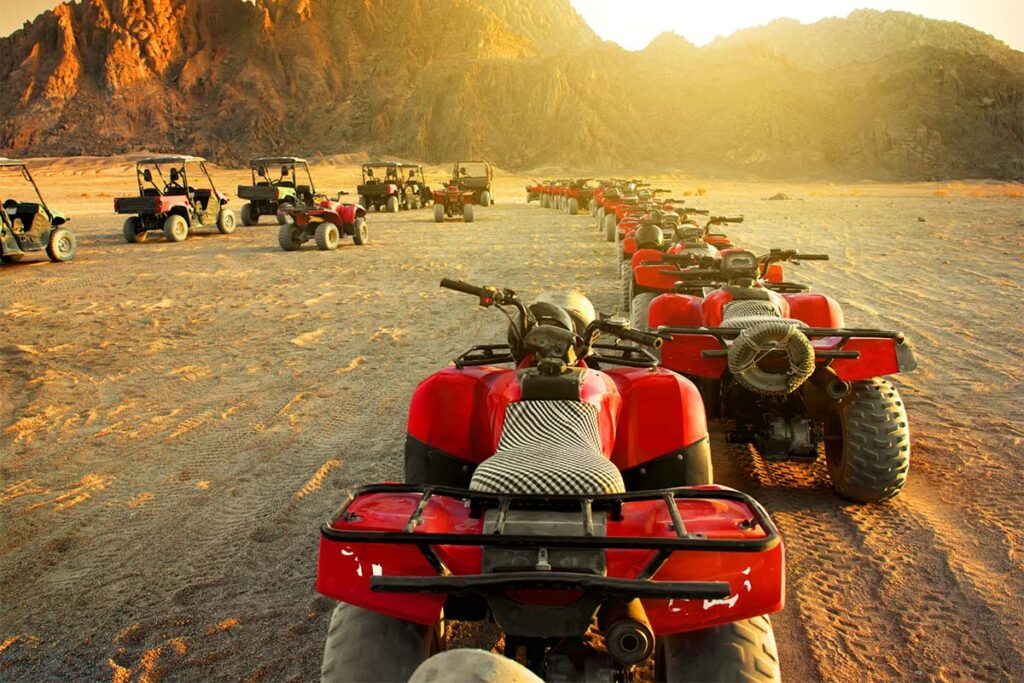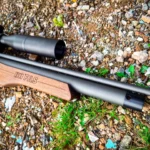Disclosure: We may get commissions for purchases made through links in this post.
Among the strongest and most reliable ATVs ever produced is the Kawasaki Prairie 650. This mean machine, launched in 2002, dominated the off-roading scene and introduced many firsts to the public – defining the sport-utility sub-segment in the process. It was one of the most successful off-road vehicles of its time, earning the “Design and Engineering Award” in Popular Mechanics and being highly regarded by ATV magazines and publications.
The Kawasaki Prairie 650 goes down in ATV history as the world’s first mass-produced quad to sport a V-Twin power mill. Apart from its monstrous 633-cm3 engine, this award-winning 4×4 boasts a variable limited-slip front differential, impressive powerband, and industry-leading features.
One of Team Green’s breakthrough machines, the Kawasaki Prairie 650, started a whole new era of high-standard behemoths – its massive torque making it a force to be reckoned with (literally!). No wonder it has inspired the creation of other iconic Kawasaki quads. Read on and learn more about the capabilities and evolution of this off-road legend.

Table of Contents
The King of Firsts
An oil-bathed, sealed rear disc brake and a variable limited-slip front differential paired with selectable 2WD/4WD – these are just some of the industry firsts that the Kawasaki Prairie 650 introduced to the market. These features may be puny for some (in today’s standards). But two decades ago, only a handful of well-engineered ORVs had these luxuries – and the lime-green wheeler was one of them.
Initially conceptualized as a utility quad, the Prairie soon morphed into a sport-utility four-wheeler to cater to the increasing number of riders gravitating toward dual-purpose, big-bore machines.
Launched as a 650-class ATV, the Kawasaki Prairie 650 soon upgraded to a 697-cm3 power mill in 2004. The Prairie left the Brute Force lineup to carry on the slightly smaller engine displacement for a little while – as the said series eventually released the Kawasaki Brute Force 750 4x4i five years after.
Whether it be the 650- or 700-class trim, both big-bore machines had dual carbs and shared almost similar vehicle dimensions. Undoubtedly, this uncanny resemblance between the two is why most consumers confuse one with the other.
Performance
This high-performance wheeler is unquestionably bulletproof. However, tight wooded trails and rough terrain are not the most suitable for this big-bore machine. The topography adversely affects the performance of its suspension system. In these environments, the Prairie falls behind its counterparts in soaking up bumps and ripples. Owners can always equip their 4x4s with Rear Shocks.
But since the front suspension is non-adjustable, it would be challenging for the quad’s suspension system to be fully optimized.
Conversely, the four-wheeler can soar through straight-line acceleration on grass tracks and straightaways. Steep engine-draining trails and mountains also become playgrounds for this beast – thanks to its differential lock, twin-carburetor setup, and unrelenting power.
In truth, the Kawasaki Prairie 650 can slice through these settings’ most technical portions with ease – but in the hands of a highly-skilled driver.
Kawasaki Prairie 650 Specs & Features
Engine
Large, 30-mm intake and 26-mm exhaust valves are set at a narrow-angle (19° intake/21° exhaust), making for a highly effective combustion chamber. A high-quality foam air filter and dual Keihin CVKR-D32 downdraft carburetors lend to the vehicle’s fuel efficiency and smooth throttle responsiveness. (TIP: When cleaning the fuel tank, never use gasoline or low flash-point solvents to avoid potential dangers of fire or explosion.)
Drivetrain
A dual-range automatic KAPS (Kawasaki Automatic Powerdrive System) CVT transmission, inclusive of the Kawasaki Engine Brake Control system and a reverse, handle the shifting. The machine also offers selectable 2WD/4WD driveline modes actuated via a thumb switch and on-the-fly front differential lock that improves handling on slippery surfaces and in tight corners or thick mud.
Ignition
The KACR (Kawasaki Automatic Compression Release), paired with an electric-recoil starting system, makes starting the Prairie 650 a breeze. A cigarette-style DC outlet at the handlebar base and a trailer-type connector at the rear provide quick, accessible power for electronic accessories.
At some point, you would need to swap out stock batteries. If so, a Kepworth KP14-BS 12V LiFePO4 Battery (view on Amazon) would be a good replacement – it is leak-proof and has a low self-discharge rate.
Tires & Brakes
Dual front hydraulic disc brakes fitted with dual-piston calipers and enclosed oil-bathed multi-disc rear disc brakes provide stopping power. This brake system mates to a Kawasaki-exclusive Engine Brake Control system that electronically observes ground speed and uses engine compression to slow the quad down.
Suspension
Minimal differences can be observed between the Prairie 360 and this machine’s suspension components since the former is an exact carbon-copy of the latter. The caster angle and rear suspension wheel travel were improved a bit, while the rest remained unchanged.
Dimensions
While the Prairie 650 weighs the same as its smaller-displacement sibling, this 4×4 has a larger trailer weight and carrier capacity. The curb weight is 294.06 Kg/648.3 lbs – merely 5.0 lbs more than the Brute Force 650.
Exterior
Unlike Team Green’s 300-class four-wheelers, the Prairie 650 did not fall short on instrumentation. A multi-function meter comes standard across all trims and year models. Adjustable footpegs atop full footboards make long trail rides enjoyable. The saddle comfortably sits taller riders. Plus, the machine’s tubular space frame allows owners to personalize their wheelers with aftermarket Kawasaki Prairie 650 parts and accessories.
K-EBC™ (Kawasaki Engine Brake Control)
The K-EBC™ system enhances the quad’s brake systems with the engine’s additional braking force. Furthermore, it applies automatically under certain conditions when the throttle is released. This feature is ideal for use when descending steep declines, becoming an added safety measure that keeps the speed of the Prairie safe regardless of the type of terrain, rider skill level, or operating conditions.
However, note that the K-EBC™ is best as a supplemental braking system at low speeds (between 3-20 km/h) and does not work in reverse.
Kawasaki Prairie 650 Pricing
The table below shows the list price of all Kawasaki Prairie 650- and 700-cc models and trims released from 2002 to 2006 (Source: Nada Guides):
Surprisingly, auction listings are slightly higher than retail pricing and range from $775 to $4,510. Resale units are mostly 2002-2003 models – vehicle conditions vary depending on the year, trim, and upkeep done by the previous owner. Typically, pre-loved Prairies have 8,000 miles, 430 to < 1,900 hours, and with no title.
Rare finds, on the other hand, are freshly overhauled and come with a recovery winch like Mile Marker 77-53120W Premium Sealed Electric Winch (view on Amazon) or aftermarket wheels/tires. If you want to be guaranteed a Prairie in near-mint condition, be prepared to spend at least $2,800 for a secondhand unit.
Known Issues of the Prairie 650
The Kawasaki Prairie 650 4×4’s service manual contains troubleshooting steps that would solve most of its common problems. But for more persistent challenges, you need to visit forums and other Kawie community sites to get specifics on how to resolve them. Here are some of the machine’s more prevalent issues and their corresponding fixes:
Cold-starting Hiccups
If the Kawasaki Prairie 650 quads had one major setback, that would be a specific functionality of its monstrous V-Twin engine. This powerplant retards the vehicle’s ignition until it reaches a certain RPM, leading to a difficult engine startup – particularly on a cold February morning.
If you are a long-time Prairie owner, you would know that the choke is used more frequently during cold weather. Otherwise, you may want to check if the under-seat valve is turned on or if there is any obstruction in the petcock valve, causing possible fuel starvation.
Faulty K-EBC™ and 2WD/4WD Actuators
The engine brake system and driveline actuators of the Prairie 650 are quite an upset for Kawie riders, as they are not known for their durability. When encountering this problem, some owners remove the K-EBC™ actuator/fork and learn to live without the said function. Others choose to remove the 2WD/4WD actuator, modifying it to have a choke cable setup to run manually.
However, addressing the issue entails more than just pinning the blame on the actuator/controller alone. Defective electrical components could also cause the problem, such as:
- Shorted/Open speed sensor
- Forward/Reverse gear detecting a shorted/open sensor
- Controller (10 Amp) fuse blown
- Disconnected battery
Leaking Oil Seals
Engine and front/rear differential oil seals on the Kawasaki Prairie 650 tend to leak. Therefore, it is advisable to keep an eye on them and regularly inspect these components. Oil seal lips that are misshapen, discolored, or hardened indicate rubber deterioration and warrant immediate replacement. The same goes for oil seals that are visibly damaged or dried out.
Veteran owners do not recommend jumping while in 4WD, as this also aggravates the leaking problem. It would also be wise to check other things like degraded valve gaskets, damaged driveshaft/axles, and oxidation on the shaft and other metal surfaces. Quads that have sat for a while are also more likely to have this problem than those frequently used and properly maintained.
Weak Choke Springs
First-year Prairie 650 carburetors had flimsy choke springs that caused gasoline to fill the engine when not in use. Similarly, post-2002 models had sticky choke plungers that resulted in poor idling. The permanent fix for this issue was to replace the stock choke springs with a later-model-year variant.
Turning off the petcock valve when the quad is not in use also helps, especially before trailering or storage (and for extended periods). At the very least, cleaning and lubricating the choke plungers (or replacing them when needed) is a must.
Other Problems
- MacPherson Strut springs are too soft for fast-paced riding.
- Airbox snorkel and CDI are too restrictive.
- Swingarm bearings and rear secondary clutch wear out prematurely.
- The fuse box connections are prone to corrosion.
- The stock radiator fan breaker (a.k.a. buss connector) tends to malfunction.
- Mounting bolts on the rocker arm shaft tend to loosen, potentially causing catastrophic damage to the motor’s top-end.
Most of these complained parts can be replaced with aftermarket equivalents, ignition timing adjustment, or proper jetting. Others are resolved or prevented through religious upkeep of the machine and avoiding over-the-top activities.
Do not worry – sport racing, serious mudding, and ripping through the dunes are not prohibited. But please, do these in moderation. And remember to clean your four-wheeler thoroughly after every ride.
About Kawasaki
Kawasaki Heavy Industries, Ltd. is a prominent institution in the ATV landscape and maker of industry-leading vehicles like the Kawasaki Prairie 650. The Japanese firm was founded in 1878 and traces its humble beginnings to being a part supplier for shipping businesses.
Since then, this world-renowned manufacturer has ventured into other transport industries and grown into massive production of transit, aerospace and energy systems, hydraulic machinery, motorcycles, off-road vehicles, side x sides, and personal watercraft.
Conclusion – Kawasaki Prairie 650 Review
One thing often overlooked about high-performance quads like the Kawasaki Prairie 650 is that they require a certain level of maintenance and care. What all riders must realize is top-caliber 4x4s are usually the most finicky. Therefore, flimsy parts or factory-assembly flaws are not always responsible for wear and tear. Driving conditions and not rider behavior have more of an adverse impact on the longevity of our vehicle.
All in all, this highly-acclaimed trail beast is a dream to ride. Its smooth but monstrous power delivery, low-range torque, well-designed chassis, and other best-engineered mechanisms only prove why present-day off-road icons took inspiration from this big-bore machine. If you want a four-wheeler that can conquer slow-crawling sections as well as high-altitude areas, then look no further than the hardworking and timeless Kawasaki Prairie 650.











































